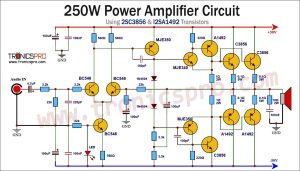Introduction
A temperature controlled relay switch is a useful device that can automatically control the operation of various electronic systems based on the ambient temperature. In this article, we will discuss how to make a temperature-controlled relay switch using the LM358 IC, BC547 transistor, 10k thermistor, 3V & 9V Zener diode, and 10k trimpot. These components are readily available in the market and can be easily assembled to create an efficient and reliable temperature-controlled relay switch.
Introduction to Major Components:
LM358 IC:
The LM358 IC is a widely used operational amplifier designed for general-purpose applications. It consists of two independent, high-gain, internally frequency compensated operational amplifiers. The LM358 IC operates over a wide range of voltage supply, typically from 3V to 32V. It has a low input offset voltage, low input bias current, and high input impedance. These features make the LM358 IC an ideal choice for various analog circuits, including temperature control systems.
BC547 Transistor:
The BC547 is a popular NPN bipolar junction transistor (BJT) with a maximum collector current of 100mA. It is commonly used in low-power applications such as amplification, switching, and driving loads. The BC547 transistor has a low base current requirement, making it suitable for driving directly from the LM358 IC. The combination of the LM358 IC and BC547 transistor allows us to control the relay switch based on the output of the LM358 IC.
10K Thermistor:
A thermistor is a type of temperature-sensitive resistor that exhibits a change in resistance with variations in temperature. The 10k thermistor, which has a resistance of 10,000 ohms at 25 degrees Celsius, is commonly used in temperature-controlled applications. As the temperature increases or decreases, the resistance of the thermistor changes accordingly. By measuring the resistance of the thermistor, we can determine the temperature and use it to control the relay switch.
Zener Diode:
A zener diode is a specially designed diode that operates in the reverse-bias breakdown region. It is primarily used to regulate voltage and provide voltage reference in a circuit. The 3V and 9V zener diodes can be used to generate a stable reference voltage for the LM358 IC. This reference voltage can be compared with the voltage across the thermistor to determine the temperature and trigger the relay switch accordingly.
10K TRIMPOT:
A trimpot, also known as a trimmer potentiometer, is a three-terminal adjustable resistor. It allows for precise adjustment of resistance within its specified range. The 10k trimpot can be used to set the desired temperature threshold for the temperature-controlled relay switch. By adjusting the trimpot, we can determine the temperature at which the relay switch should be activated or deactivated.

Circuit Diagram of Temperature Controlled Relay Switch
This project can be designed using a few basic components. The circuit diagram of this project is shown below.
More Circuit Layouts








Components List of Temperature Controlled Relay Switch
Following is the list of all components used in this project:
- 1X LM358 IC
- 1X BC547 TRANSISTOR
- 1X 3V ZENER DIODE
- 1X 9V ZENER DIODE
- 2X LEDS
- 1X 47uF CAPACITOR
- 1X 1OK TRERMISTOR
- 1X 1OK TRIMPOTS
- 3X 1K RESISTORS
- 1X 2.2K RESISTOR
- 2X 10K RESISTORS
- 1X 12V RELAY
- 1X 2 PIN TERMINAL BLOCK
- 1X 3 PIN TERMINAL BLOCK
- 1X PERF BOARD
- JUMPER WIRES
Construction of Temperature Controlled Relay Switch
To construct a temperature-controlled relay switch, follow following steps:
- Insert LM358 on board and connect its pin-4 to ground and pin-8 to +12V. Also insert a 2-pole terminal block and connect its one side to +12V supply and other side to ground.
- Insert a 3v Zener diode and connect its cathode to pin-3 of LM358 IC and anode to ground. Also connnect a 10k resister from +12V to pin-3 of LM358 IC.
- Insert 10k Trimpot and connect its center pin to pin-2 of LM358 IC. Its pin-1 to 10 Thermister while other pin of thermistor to +12V. Also connect a 10k resister to pin-3 while other side of the resister to ground.
- Insert a BC547 transister on the board and connect its pin-3 to ground. Connect a 1k resister from pin-2 to ground. Also connect a 10 resister to the same pin-2 of BC547 transister to pin-1 of LM358 IC. Now connect anode of 1n4148 diode to pin-1 of BC547 transistor and cathode to +12V supply.
- Insert an LED light and connect its anode to +12V. Also connect a 1k resister to cathode of LED while the other side of 1k resister to pin-1 of LM358 IC.
- Insert a Relay and connect its Normally Open pin to one side of a Terminal Block and connect its Common pin to the other side of the Terminal Block. Now connect its pin-1 to +12V supply.
- Now finally, connect positive side of one 47uf capacitor’s pin to +12V supply and negative side to the pin-2 of relay coil.
Conclusion of Temperature Controlled Relay Switch
In conclusion, a temperature controlled relay switch can be easily constructed using commonly available components such as the LM358 IC, BC547 transistor, 10k thermistor, 3V & 9V zener diode, and 10k trimpot. The LM358 IC, with its high gain and low power consumption, provides the necessary amplification and signal conditioning for the temperature measurement. The BC547 transistor acts as a switch to control the operation of the relay based on the output of the LM358 IC. By adjusting the 10k trimpot, the desired temperature threshold can be set, allowing for accurate temperature control. This temperature-controlled relay switch can be used in various applications, such as temperature-regulated cooling systems, industrial processes, and home automation.
More projects, You may like:
- Video Transmitter DIY Homemade FM Radio Transmitter
- Adjustable Power Supply DIY Battery Charger
- 12V-220V 500 Watt inverter DIY Homemade
- 12V-220V H-Bridge Inverter DIY Homemade
- MPPT Solar Charge Controller DIY Homemade
- 18650 battery bank free charge protection module
- D718 B688 Bass Amplifier Homemade DIY
- C5200 Bass Amplifier DIY Homemade with Volume
- DIY LA4440 bass amplifier homemade
- C5200 A1943 TDA2030 Amplifier DIY Homemade
For more project and circuit diagrams, you can go through the Schematics in the main menu where you can find many interesting projects and circuit diagrams like audio amplifier circuits, voltage booster circuit, battery charger circuit and timer circuits etc., which are all beginner circuit projects. Feel free to check them out!
Thanks for visiting the article and watching the video.




























